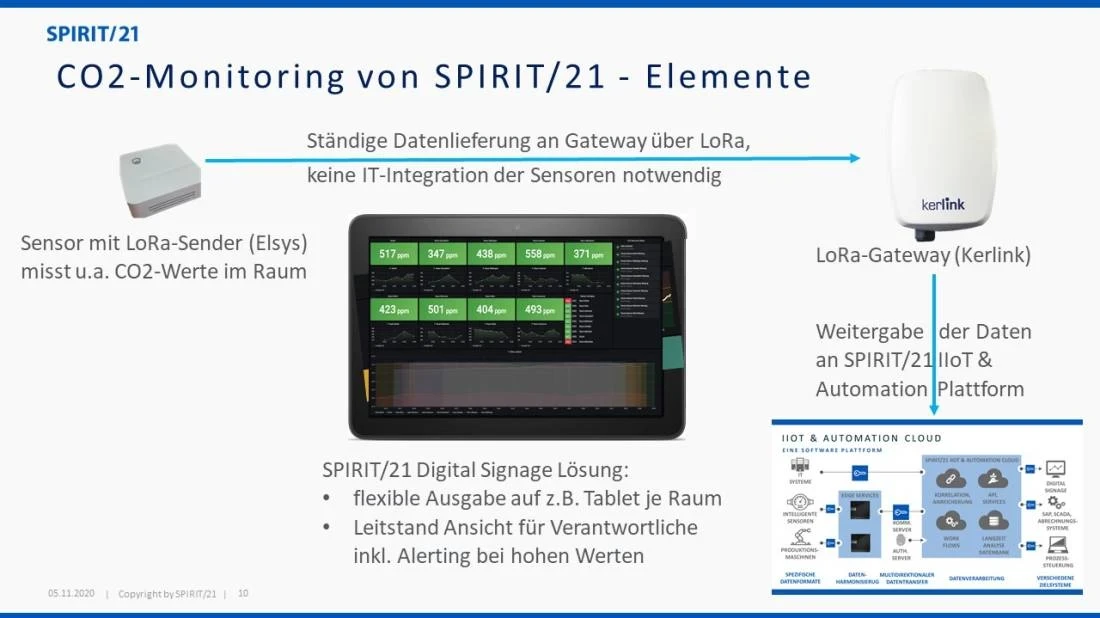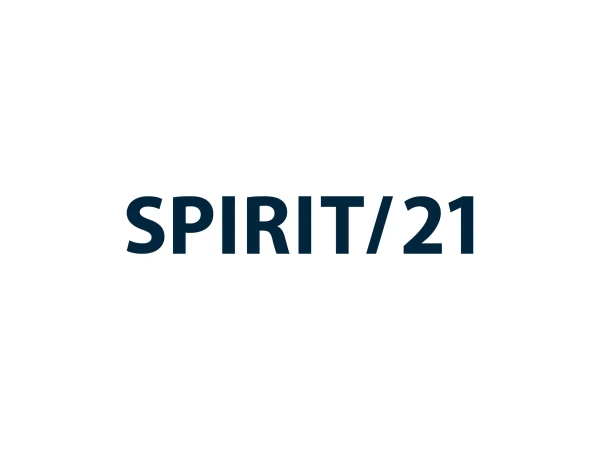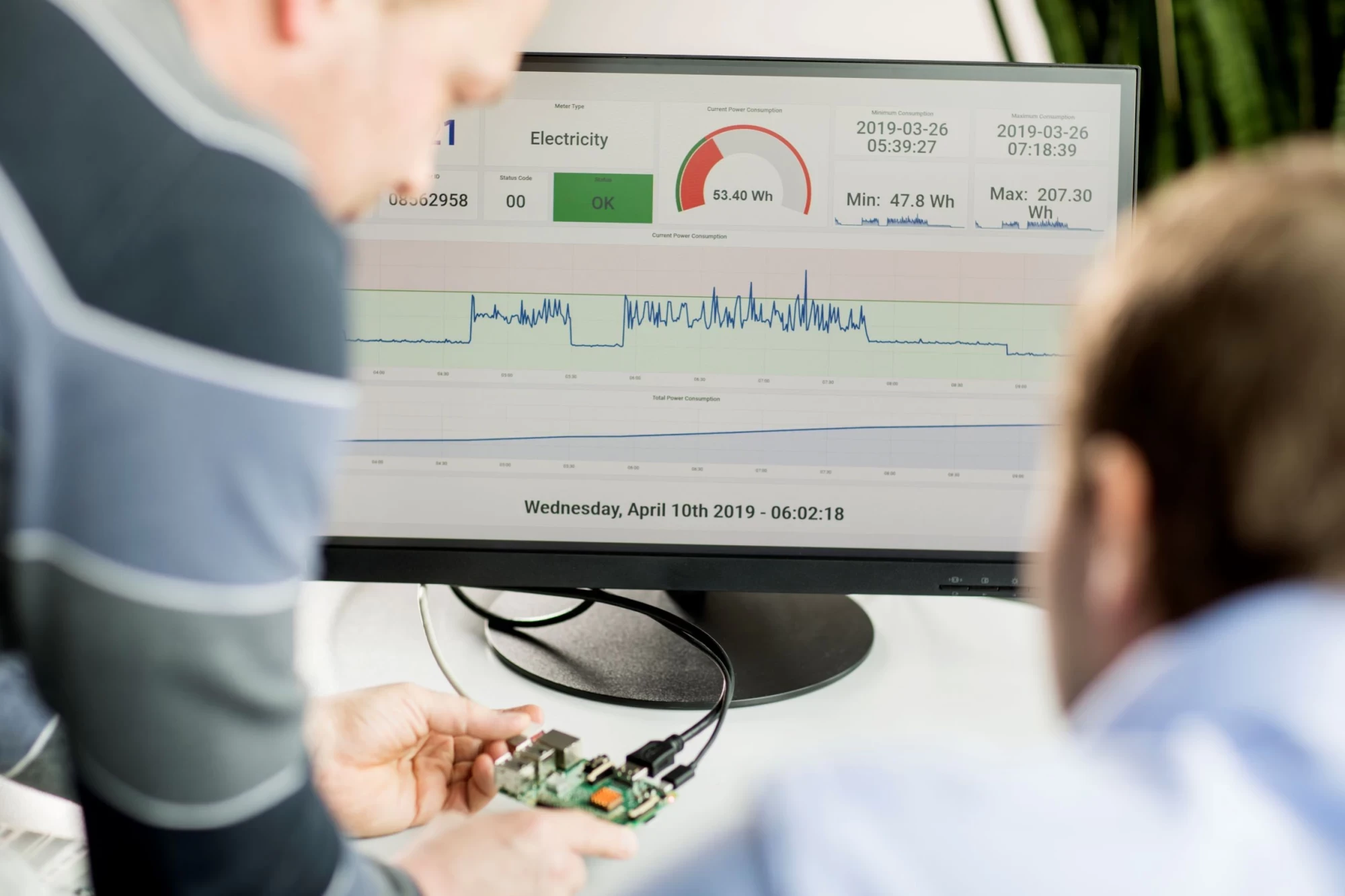Smart IoT solution to combat stale air: how the indoor climate can be monitored automatically
In times of corona, ventilation is the order of the day. But how often and for how long should windows be opened? And why does ventilation actually make sense? It is now undisputed that Sars-CoV-2 spreads via aerosols. In addition to CO2, exhaled air also contains these tiny particles which, unlike larger liquid droplets, do not sink to the ground but can float in the air for a long time. If someone is infected with the virus, these suspended particles can also contain virus particles. If a healthy person breathes in a certain dose of the contaminated aerosols, the disease is transmitted. With the CO2 monitoring solution from SPIRIT/21, the indoor climate can be automatically monitored and centrally controlled, even in large building complexes.
What does the CO2 concentration actually have to do with the risk of coronavirus infection?
The more CO2 particles there are in the room air, the greater the proportion of air that has already been breathed several times. This also increases the likelihood of inhaling aerosols that another person in the same room has previously exhaled. The CO2 concentration is therefore an indication of how many - possibly virus-laden - aerosols are in the room air. CO2 sensors measure the carbon dioxide content in the air. This makes it possible to reliably determine when the critical value has been reached. According to the Federal Environment Agency, this is 1,000 ppm (parts per million).
Measuring the CO2 concentration is therefore a good method for assessing the air quality indoors and therefore the potential risk of infection. Ventilation reduces the risk of infection. This is because the more fresh air is supplied, the more the aerosols in the room air are diluted.
“Correct” ventilation depends on many different factors
If too little ventilation is provided, the risk of infection increases. However, if too much ventilation is provided, a lot of heat is lost, especially in winter, which is contrary to environmental protection and can drive up heating costs. How often and for how long ventilation should ideally take place depends on a number of factors, including the size of the room and the number of people present. Humidity and temperature differences between indoors and outdoors also play an important role.
In a few rooms close together, the influence of these factors can still be controlled relatively well with the help of easy-to-use CO2 measuring devices, so-called “CO2 traffic lights”. However, if the indoor climate is to be monitored around the clock in larger building complexes with many individual, differently used indoor rooms, possibly also at different locations in several countries, this method reaches its limits.
Automate CO2 monitoring
SPIRIT/21 has developed a solution for precisely this scenario, with which the CO2 concentration can be automatically measured and monitored via LoRa-WAN™. The technology is based on an open source software-based low-code platform that is extremely flexible and highly scalable. The low-power wireless network protocol LoRa-WAN™ (Long Range Wide Area Network) offers a number of advantages here: Many different sensors are available that have long wireless ranges and are easy to handle. In CO2 monitoring, sensors with LoRa transmitters measure the carbon dioxide levels in the rooms and deliver the data to a LoRa gateway, which forwards it to the IIoT and automation platform from SPIRIT/21. This platform processes the measured values graphically. The SPIRIT/21 digital signage solution displays this dashboard with the measured values individually and tailored to the respective requirements.

However, this solution goes far beyond pure CO2 monitoring. Based on the IIoT and automation platform, a wide variety of use cases can be implemented with a single software package. It is suitable for innovative building management applications, such as controlling ventilation systems, evaluating room occupancy and booking workstations or meeting rooms via apps.
A platform for every use case
The operation, monitoring, alerting and defect management of the CO2 monitoring solution, including the sensors, is carried out centrally, regardless of the location of the rooms. This ensures that CO2 monitoring functions correctly at all times.
All data is transferred from the sensors to the central data storage system and stored. As a result, they are fully traceable and can also be evaluated retrospectively over longer periods of time - this distinguishes the SPIRIT/21 approach from solutions with stand-alone measuring devices. The measurement results are visualized in real time via dashboards, providing a detailed picture of the entire environment at all times, regardless of the number of data records.
Learn more

What are the advantages of introducing a hybrid cloud approach and what obstacles need to be overcome when doing so?

DKIM is a complex email authentication method, but it offers many advantages: a guide for administrators. Part 2 of the blog series “Security through email authentication methods”

Microsoft Teams is now widely and regularly used for collaboration in many companies. We provide information on what’s new in this powerful tool and how best to use it.
Team SPIRIT/21
E-Mail: info@spirit21.com
The SPIRIT/21 team will be happy to advise you on all aspects of your IT tasks, from consulting and implementation to the operation of individual services and complete IT infrastructures. We deliver solutions that work. We look forward to hearing from you.

